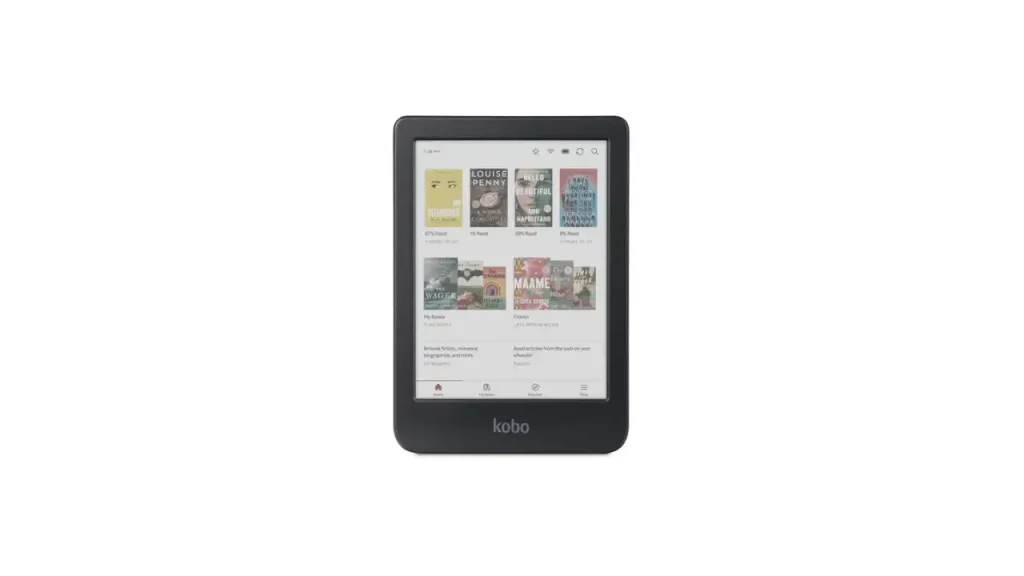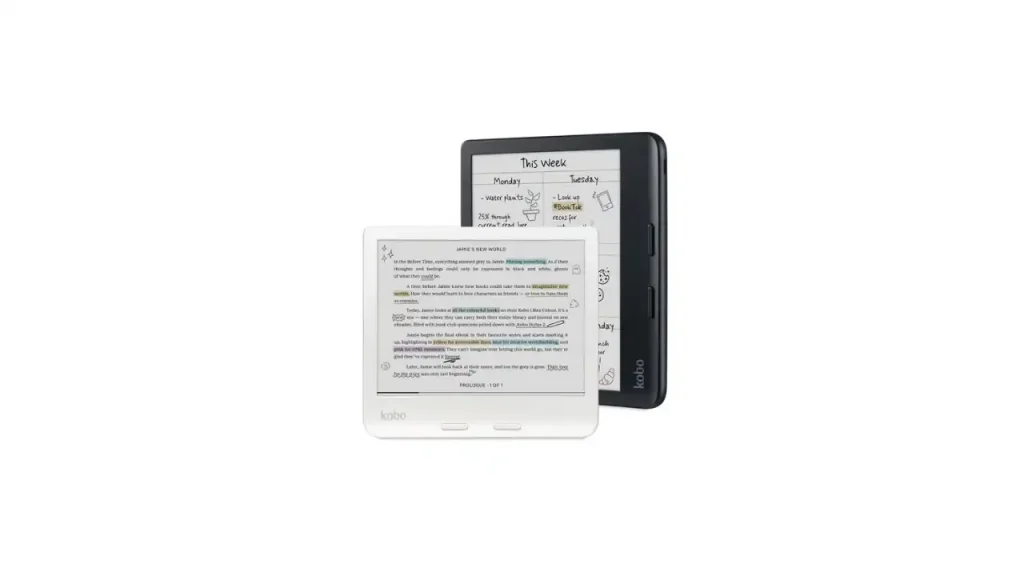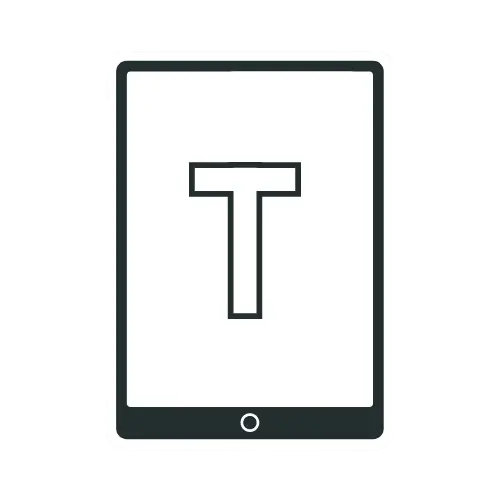Best Color E-Readers: The Ultimate Buying Guide

The journey to color e-readers has been a long one, starting with the Ectaco jetBook Color back in 2011. It was groundbreaking then, but the technology took nearly a decade to catch on with consumers. Now, things have changed. Color e-ink is here, and it’s finally delivering on the promise of vibrant, full-color reading on e-paper.
In this article, I’ll explore the five best color e-readers across different budget segments. From premium models to affordable options, I will help you find the perfect color e-reader for your needs and budget. Let’s explore these vibrant e-readers and discover which ones deliver the best reading experience.
The Quick List
| Top Pick | Kobo Libra Colour | Check Price |
| Best Android Color E-reader | Boox Go Color 7 Gen II | Check Price |
| Best Ergonomic | Pocketbook Era Color | Check Price |
| Best Budget | Kobo Clara Colour | Check Price |
| Best for Amazon Ecosystem | Kindle Colorsoft | Check Price |
Specs Comparison
| Specs | Kobo Clara Colour | Boox Go Color 7 Gen II | Pocketbook Era Color | Kobo libra Colour | Kindle Colorsoft |
| Display | 6″ Kaleido 3 | 7” Kaleido 3 | 7” Kaleido 3 | 7” Kaleido 3 | 7” Kaleido 3 |
| CPU | Dual Core 2.0 GHz | Octa-core | Quad Core (1.8 GHz) | Dual Core 2.0 GHz | 2.0 GHz dual core |
| RAM & ROM | 1GB+16GB | 4GB+64GB | 1GB+32GB | 1GB+32GB | 1GB+32GB |
| Battery | 1500 mAh | 2300 mAh | 2500 mAh | 2050 mAh | 2310 mAh |
| Buttons | N/A | Available | Available | Available | N/A |
| Stylus Compatibility | N/A | InkSense stylus touch | N/A | Kobo Stylus | N/A |
| Waterproof | IPX8 | N/A | IPX8 | IPX8 | IPX8 |
| OS | Kobo firmware | Android 13 | Linux 4.9.56 | Kobo firmware | Kindle OS |
| Weight | 174g/6.14oz | 195g/6.9oz | 235g/8.29oz | 199.5g/7.04oz | 219g/7.7oz |
Kobo Clara Colour

The Kobo Clara Colour is an excellent entry-level device for those curious about color e-readers. Its compact and lightweight design makes it easy to carry around and read on the go.
The device features a 6″ Kaleido 3 screen, which, though smaller than some competitors, offers a vibrant reading experience. While the color display isn’t as vibrant as a tablet, it strikes a good balance between color reproduction and the eye-friendly nature of E Ink. However, the smaller screen size may not be ideal for extensive reading sessions or for those who prefer larger displays.
One of the significant benefits of the Clara Color is its integration with OverDrive, which enables you to easily borrow books from your local library. Plus, you get access to millions of ebooks through Kobo’s ecosystem, and the Kobo Plus subscription gives you unlimited reading for a monthly fee.
A downside, though, is the lack of wireless file transfers via Google Drive or Dropbox, a feature found in the Kobo Libra Color. It’s not a deal-breaker, but it’s something to consider.
While it might not have all the premium features of higher-end models, the Kobo Clara Color is a solid, affordable choice for anyone wanting to dip their toes into the world of color eReaders. I just wish the screen were a little bigger for a more immersive feel.
| Pros | Cons |
|---|---|
| Affordable and ideal for those new to color e-readers. | The smaller screen size may not be ideal for extended reading sessions. |
| Compact and lightweight, making it easy to carry and read on the go. | Lacks Google Drive or Dropbox file transfer support, unlike other models. |
| Seamlessly borrow books from local libraries via OverDrive integration. |
Boox Go Color 7 Gen II

The Onyx Boox Go Color 7 Gen II is a mid-range option that offers the best of both worlds: a 7″ Kaleido 3 display and the flexibility of Android 13. Its lightweight build, weighing just 195 grams, and slim dimensions make it a portable choice for readers.
The 7-inch Kaleido 3 display offers 1680 × 1264 resolution, delivering crisp 300 ppi for monochrome content and 150 ppi for color. Boox’s latest firmware does a commendable job of minimizing ghosting compared to the Gen 1 model, so flipping between text and images feels snappy and clean. As with most Kaleido screens, colors are a bit subdued unless you bump the front light up past 20%, but the warmer white point compared to the Tab Mini C makes comics and illustrations pop just a little more.
What sets the Go Color 7 apart is its software flexibility. Running Android 13 with Google Play support, you can install just about any reading app you like—Kindle, Readwise Reader, you name it. The octa-core processor, paired with 4GB of RAM, handles most reading applications smoothly. Boox’s E-Ink Center allows you to select HD, Balanced, or A2 modes per app for the optimal trade-off between clarity and speed.
Physical page-turn buttons are a welcome touch, making navigation effortless, and the 2,300mAh battery holds up well for extended reading sessions. The addition of a microSD slot is a nice bonus, especially if you have an extensive library or prefer to keep a variety of comics and reference materials on hand.
However, the writing experience feels imprecise and lacks the natural feedback that made previous Boox devices excellent for note-taking. The switch from Wacom EMR to InkSense stylus technology is a definite step back. The 1.6 mm fat nib and unpredictable pressure curve make fine writing difficult, although palm rejection is solid. The stylus also requires a separate purchase and charging, while compatibility with popular third-party pens has been eliminated. That said, the built-in Notes app remains best-in-class, with features such as layers, shapes, and direct PDF export that power users will appreciate.
At its current price point, the Go Color 7 Gen II excels as a dedicated color e-reader, particularly for graphic novels, illustrated books, and educational materials where color adds value. However, those prioritizing handwriting should explore larger alternatives with better stylus support.
| Pros | Cons |
|---|---|
| Android 13 with Google Play support for app flexibility | Colors subdued unless front light is above 20% |
| Minimal ghosting compared to previous gen | Writing experience is imprecise due to InkSense stylus (not Wacom) |
| High-end specs 4GB RAM and 64GB storage | |
| Physical page-turn buttons | |
| Best-in-class Notes app with layers, shapes, PDF export |
Pocketbook Era Color

The major selling point of Pocketbook Era Color is undoubtedly its sleek form factor. The asymmetrical design, with a comfortable grip area on one side, makes it a pleasure to hold for long reading sessions. At first glance, the angled bezels might seem purely aesthetic, but they actually offer an ergonomic advantage, allowing for a more natural hand position. The buttons are conveniently placed along the bezel, although I wish they were a bit more tactile, similar to the ones found on PocketBook’s InkPad series. The flush, scratch-resistant front glass is a first for PocketBook’s color e-readers, giving it a modern and premium feel.
As a Color E-Reader, the PocketBook Era Color is a solid option. While the colors may not be as vibrant as on a tablet, the 7-inch E-Ink Kaleido 3 screen, which offers 150 PPI for color, ensures a comfortable reading experience that’s easy on the eyes. Like other Kaleido 3 screens, it is darker than a typical black-and-white E-Ink display, but PocketBook has optimized the settings for better readability. I’d recommend tweaking the default settings for even more vibrant colors. The screen works great in bright sunlight without needing the front light, but indoors, you might need to set the light to around 25%, even in a well-lit room.
Ghosting is minimal when reading text but more noticeable when viewing images. Thankfully, you can reduce this by setting the screen to refresh with every page turn.
The reading experience on the PocketBook Era is perfect. The device performs quite well while reading standard eBooks, PDFs, or comics. With a wide range of font customization options, text-to-speech functionality, and access to multiple dictionaries, the device makes reading accessible and enjoyable. One downside is that it doesn’t support Audible due to restrictions; however, you can still load your audio files. The built-in speaker is decent, although you may prefer using Bluetooth headphones for improved audio quality.
One thing to note: the PocketBook Era Color doesn’t have dedicated stylus support, but you can take notes using your fingers. It’s not as responsive as a stylus-equipped device like the Remarkable, but it’s a nice feature to have nonetheless.
The PocketBook Era Color also allows you to purchase books through Google Books in the United States, and it supports Kindle’s “Send to Kindle” feature, which works seamlessly. Syncing content across devices is easy with PocketBook’s Cloud service and app, allowing you to access your books on your phone or tablet.
While the battery life isn’t groundbreaking, it’s respectable for a color display device. The front light does drain the battery, but you’ll still get about 11 hours of usage with brightness set to 100% and page refresh intervals of 15 seconds.
With a solid build, customizable software, 32GB of storage, wireless charging support (via an optional case), 5GHz WiFi, a 2,500mAh battery, and IPX8 water resistance, the PocketBook Era Color is a strong contender in the color E-Ink niche. If you’re looking for a feature-rich color e-reader with great ergonomics, the PocketBook Era Color is definitely worth considering.
| Pros | Cons |
|---|---|
| Sleek, ergonomic design with a comfortable grip for long reading sessions. | Muted color vibrancy may not meet expectations. |
| Scratch-resistant front glass adds a premium feel and protects the display. | No stylus support: while you can take notes with your fingers, it lacks dedicated stylus functionality. |
| Ideal for reading various content, including PDFs and comics. | |
| Strong ecosystem support with cloud sync, Google Books integration, and compatibility with Kindle’s “send to Kindle” feature. | |
| IPX8 rating for added durability. |
Kobo Libra Colour

The Kobo Libra Color takes everything great about the Clara Colour and elevates it to the next level. The larger 7-inch display provides a more immersive reading experience. Although the price may seem steep, it comes with several notable features.
The 7″ E Ink Kaleido 3 display is fantastic for black-and-white text, giving you crisp 300 ppi clarity. While the color resolution is lower at 150 ppi, it’s still great for reading comics and magazines. The colors appear pastel-like, making them gentle on the eyes.
What I really like about the Kobo Libra Color is its asymmetrical design. The asymmetrical design means it’s heavier on one side than the other, so you tend to switch hands more frequently due to the off-center weight. However, it is comfortable for me, and since the device is lightweight, my hands don’t get tired easily, so I don’t have to switch hands constantly.
The physical page-turn buttons are also a great addition, especially for one-handed reading. And if you’re someone who frequently switches hands, the auto-rotating screen makes it super easy. The buttons even remap themselves, so you’re never fumbling around.
The ComfortLight PRO is another big win. You can adjust the warmth of the light, making it ideal for reading in any setting, whether bright daylight or nighttime. And since it’s waterproof (IPX8, up to 60 minutes in 2 meters of water), you won’t have to worry about bringing it to the beach or pool.
The battery life for my use case is 35 to 40 hours per charge, which is roughly the same as for the Kobo Clara. So, battery life isn’t a factor either, since it’s based on usage. If you read with 0% brightness, your battery will last longer. However, if you run with brightness constantly set to 50% or higher, your battery will be drained, regardless of the device you use.
One of the standout features of the Libra Color is its compatibility with the Kobo Stylus 2. The stylus is accurate and responsive, although there’s a slight delay when you first start writing. It’s minor but worth noting, especially since the Notebooks feature can feel a bit sluggish.
As with all Kobo devices, the Libra Color works seamlessly with Kobo’s ebook store and the Kobo Plus subscription. You also get a built-in OverDrive for easy borrowing from your local library, which adds a lot of value for keen readers.
Overall, the Kobo Libra Color is a great all-around e-reader. It’s comfortable, feature-packed, and ideal for anyone seeking a color e-reader with physical page-turning buttons and note-taking capabilities.
| Pros | Cons |
|---|---|
| Larger 7-inch Kaleido 3 display offers a more immersive experience, perfect for comics and magazines. | The asymmetrical design (heavier on one side) may lead to frequent hand-switching, which some may find uncomfortable over time. |
| ComfortLight PRO provides adjustable warm and cool light settings for different environments. | Higher price point, more expensive compared to other options. |
| Asymmetrical design with physical buttons makes it ideal for one-handed reading with an auto-rotating screen. | |
| Compatible with the Kobo Stylus 2 for note-taking and annotation. |
Kindle Colorsoft

The Kindle Colorsoft marks Amazon’s first foray into color e-ink displays, bringing vibrant displays to the Kindle ecosystem for the first time.
From the outset, Colorsoft’s biggest draw is its 7-inch Kaleido 3 e-ink display. While it shares the same e-ink color technology as rivals like the Kobo Libra Colour, Amazon has put its spin on things with a custom display stack (brighter LEDs and special coatings). The result? Crisp 300 PPI for black-and-white text and 150 PPI for color content. This means text remains crisp, while color images, comics, and annotations finally come to life, albeit with the pastel, muted tones typical of all current color e-ink devices.
You get two color modes: Standard for balanced, everyday reading, and Vivid for when you want comics and illustrations to stand out. It’s useful for those who switch between novels and graphic novels.
Performance-wise, the Colorsoft is a mixed bag. Page turns are approximately 25% faster than those on older Kindles, and overall navigation feels smooth and responsive. Still, it’s roughly 50 milliseconds slower than the 2024 Paperwhite Signature Edition—a difference you might only notice in side-by-side comparisons. The color filter layer introduces a slight darkness and graininess to the screen, a typical tradeoff with color e-ink. On the plus side, the front light is impressively bright (up to 150 nits), and the auto-brightness feature is genuinely beneficial. Be prepared to keep the brightness higher than you would on a monochrome Kindle for the best results.
Battery life is solid, matching Amazon’s claim of about eight weeks on a single charge (assuming 30 minutes of reading per day at moderate brightness). That’s a bit behind the Paperwhite’s twelve weeks, but still impressive for a color device. Wireless charging and waterproofing are both on board, and Audible integration is seamless, though you’ll need Bluetooth headphones, as there’s no built-in speaker.
Where the Colorsoft truly excels is in its ecosystem. Amazon’s Kindle Store and Comixology integration make it a dream for comic lovers, with features like guided panel view and easy access to thousands of titles. Annotation is also a step up, with the ability to highlight text in four colors (yellow, pink, blue, orange)—a real boon for students and heavy note-takers.
It’s not all perfect. The Colorsoft comes with a steep price tag, especially when compared to competitors like the Kobo Libra Color or Onyx Boox Go Color 7 Gen II, which offer additional features such as physical page-turn buttons. Early units also suffered from yellow banding along the bottom edge of the display, prompting a temporary halt in shipments. While not all units are affected, and software updates have addressed many issues, it’s still something to keep in mind.
In short, if you’re deeply invested in the Kindle ecosystem or color is what you crave, the Colorsoft is the best color e-ink Kindle you can get. It asks a bit more from your wallet, but you’re rewarded with color, robust battery life, waterproofing, and Amazon’s unmatched content library—all without sacrificing the core Kindle experience.
| Pros | Cons |
|---|---|
| Amazon’s custom display stack for brighter LEDs and coatings | Early units had yellow banding issue (mostly fixed) |
| Page turns 25% faster than older Kindles | |
| Solid battery life (about 8 weeks at 30 min/day) | |
| Excellent Kindle Store and Comixology integration |
Conclusion
Choosing the right color e-reader ultimately comes down to your reading habits, budget, and the features you value most. Whether you’re looking for a premium device with stylus support, a flexible Android reader, an ergonomic design, or an affordable entry point into color e-ink, there’s an option on this list to match your needs.
Each device brings something unique to the table:
– Kobo Clara Colour offers an affordable and compact choice for those new to colour e-readers.
– Boox Go Color 7 Gen II stands out for Android flexibility and app support.
– Pocketbook Era Color impresses with its ergonomic build and customizable software.
– Kobo Libra Colour shines as a balanced all-rounder, offering stylus support and OverDrive integration.
– Kindle Colorsoft is the go-to for Amazon loyalists and comic enthusiasts, thanks to its deep ecosystem integration and robust comic features.
No matter which device you choose, the latest generation of color e-readers finally delivers on the promise of vibrant, comfortable, and versatile reading
Recommended Readings!
9 Compelling Reasons to Choose a Color E-Reader in 2025
The 5 Best Kindle Scribe Cases of 2025
